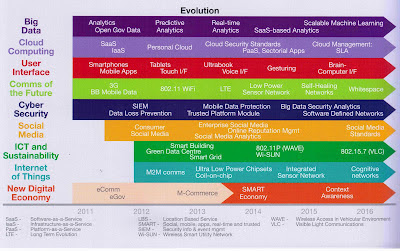IDA’s CTO Leong Mun Yuen shares Singapore’s IT Roadmap
As one of the world’s most IT savvy and digitally-connected economies, Singapore places a premium on developments in Information and Communications Technology (ICT). Almost every aspect of our lives – work, education, socialisation, recreation and increasingly even religion – are dependent on ICT. Just look around you, wherever you are, and you’ll see somebody tethered to either a smartphone, tablet, laptop or related device.
To forecast future trends and chart a path for the future, the Infocomm Development Authority of Singapore (IDA) has shared its Infocomm Technology Roadmap (ITR) 2012. Aiming to be as comprehensive as possible, ITR 2012 proposes nine key themes in which technology will develop over the next 5 to 6 years. A summary of these themes and their components can be seen in the chart below (click for larger version).

Courtesy of IDA Singapore
What do each of these nine themes mean? Let me cover each in turn:
1) Big Data
With the massive increase in people and devices connected to the Internet, our collective data needs are growing at an unprecedented rate. The amassed data pool provides useful insights for governments and companies to understand public and customer behaviours, opinions, and views. These can be harvested through various analytics and sentiment seiving tools. However, these have to be balanced against the growing concerns over data privacy and security.
2) Cloud Computing
To park everything in the “Cloud”, a considerable amount of work is needed to make computing a “public utility”. This include the establishing of standards covering areas such as security and interoperability. Web browsers also need to be enahnced to tap on the elasticity of the Cloud and its ability to improve efficiency, encourage experimentation, and improve turnaround time.
3) User Interface
Increasingly, devices play a vital role in determining how users interact with data, systems and the environment in which we work, live and play. Beyond tablets, smartphones and ultrabooks, we’re now developing more multi-sensorial interfaces involving augmented reality, eye tracking, haptics, electronic paper, and computer-brain interfaces.
4) Comms of the Future
The rise in converging technology devices makes it necessary to grow our communications backbone, pipes and spectrums such that it can accommodate the tsunami of data. Communications networks cannot just sit still as users will demand faster access to a plethora of content being streamed to their mobile devices.
5) Cyber Security
With great access to data comes great responsibility. As global crime syndicates shift their action to the web, cyber attacks would become better orchestrated and increasingly sophisticated. These threats need to be addressed critically through better means of data, device and network protection.
6) Social Media
As even grandpa and grandma hops onto the social media bandwagon, technologists must reach ahead to understand the tremendous potential of the social web. Social media’s rise has made it important for companies to identify their influencers, develop ways to manage their reputations online, as well as to measure and manage their growth on social platforms.
7) ICT and Sustainability
Yes, the world is heating up and ICT has often been blamed for this scourge. To ensure that ICT helps rather than hinders the green cause, innovations such as smart buildings, green data centres, and new standards in energy efficiency needs to be developed.
8) Internet of Things
I love this concept although it does have an Orwellian (1984) shadow. As things start to blur between what’s physical and what’s virtual, almost everything we use from refrigerators to televisions to cars to bicycles could be hooked to the web. With miniscule chips and ambient devices, these objects could be continually connnected and made more intelligent, improving their abilities to serve us in a more predictive fashion.
9) New Digital Economy
Finally, it is clear that technology will change trade and commerce. Mobile devices may rise to become handheld “shopping centres” and online payments will be made more smoothly while assuaging consumer fears of security. Retail, entertainment and learning will be transformed as bits and bytes overtake atoms as the new currency of lives.
A more detailed “mind map” of the nine themes above can be seen below (click for larger version).

Courtesy of IDA Singapore
For the complete document, check out this link here.
In the spirit of crowdsourcing and collaboration, IDA is seeking inputs from the public to “co-create the future”. Yes, this is a chance for you to help shape Singapore’s technological destiny. You can either write your views and comments in writing (both hard or soft copies) to IDA or email them ([email protected]) by 30 Sep 2012. More details can be found here.
